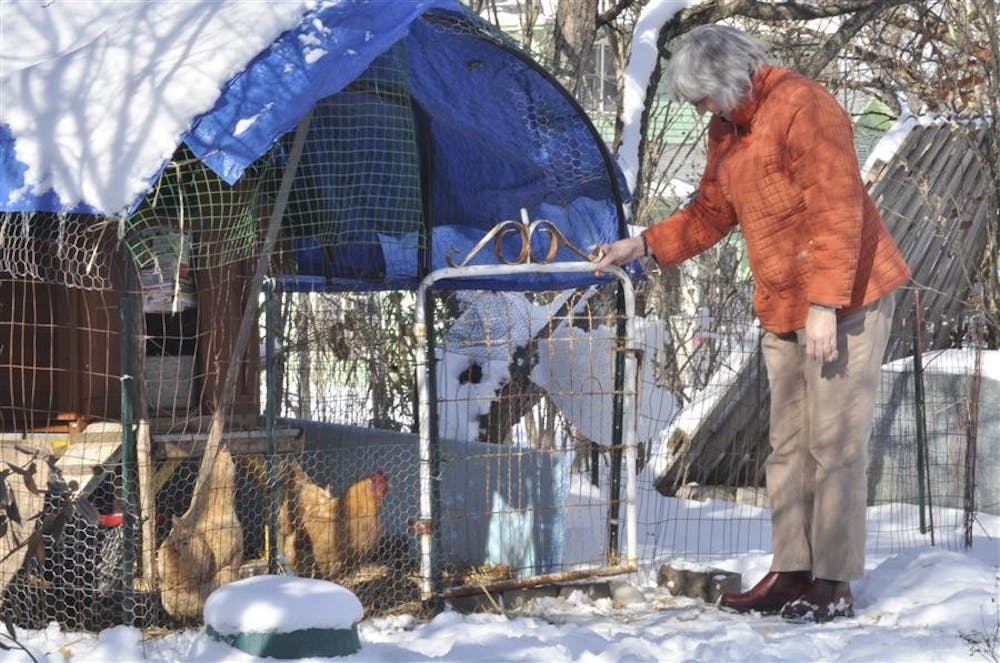Theresa Malone sits in a teal lawn chair in her backyard on a September afternoon, slowly petting the chicken perched on her lap.
She drags her fingers along JoAnn’s sandy feathers, and the chicken clucks quietly. She’s serene compared to Ruthie and Bobbie, Theresa’s two other hens scampering across the patches of grass, surrounded by thick tangles of flower beds.
In Theresa’s, and seven other backyards in Bloomington, chickens squawk.
They’re the new vogue in locavorism: an animal producing food each day within sight of the kitchen.
A 2009 article in The New Yorker dubbed them “The It Bird.” Coops have made cameos in PBS documentaries and episodes of “Extreme Makeover: Home Edition.” BackYardChickens.com, an online forum for owners, boasts more than 75,000 users.
No farmers’ market can compete with a backyard chicken’s farm-to-table distance.
“We talk about sustainability all the time in Bloomington,” Theresa says. “Aren’t chickens perfect for that?”
She sighs and goes back to petting JoAnn.
“They’re such stupid animals.” She fiddles with a feather on JoAnn’s tail. “But they’re such good company.”
Though she dotes on the hens like they’re her own feathered, helpless infants, the chickens are all named after strong women in Theresa’s past.
Ruthie and Bobbie are named after aunts and share their human counterparts’ curiosity and easygoing demeanor. Ruthie even has black-and-white feathers to match her namesake’s salt-and-pepper hair.
And JoAnn? She’s named after Theresa’s mother and has the attitude to match.
JoAnn pecks at just about anything — an exposed stripe of skin between socks and pants, a dangling forearm. It feels like being poked with a dull pencil.
“You’ve just gotta kick her away when she does that,” Theresa explains and mimes — just a quick tap at chicken-breast height with the top of her foot. Not to hurt her. Just to shoo.
As if on cue, JoAnn torpedoes her beak toward Theresa’s shoulder.
“Ow! God.”
She gently sets JoAnn back on the grass.
“God, she’s just like my mother,” Theresa says, laughing. “She’s such a bitch.”
JoAnn responds with a reprimanding nip at Theresa’s ankles.
“Go away!”
Theresa shoos.
*****
Veda Stanfield is worried.
Overnight, Bloomington has been dipped in snow and that includes her chicken coop and run. It was the first snowfall in December. Her three hens have never seen snow before, and they’ve been antsy all morning.
She knows chickens hate snow. She’s heard the stories of them cowering from massive snows under trees and porches, of frozen chickens being resuscitated from cold and shock with CPR from desperate owners.
She’s been trying to soothe Betty, Lacy and Lil with treats: some grasses her husband found during a morning walk, a plate of grapes and flaxseeds in the afternoon.
She stands inside their run, watching them peck at their snack. She checks their indoor nests for eggs — none right now. She makes sure they have enough water and that their heating lamp is working.
But she won’t look at their feet. They’re prehistoric-looking, a nod to their dinosaur ancestors. They look cold, clammy and scaly.
They creep her out.
She focuses on finding intricate patterns in their feathers, on sweeping snow off of the straw lining of their run, on scanning the skies for the hawks that will occasionally perch on top of the pen and stare hungrily at her hens.
She thinks back to the New York Times article that gave her this idea in the first place. The documentaries she’d seen on abused chickens with their beaks cut off, the idea that she’d be able to save at least a few of them from a life of forced feedings and layings.
The day, six months ago, when she ordered eight chicks off of MyPetChicken.com and waited an excruciating 36 hours for them to be delivered. The 7 a.m. call from the post office that she needed to come immediately to pick up a peeping, rustling package.
She remembers opening the box to see eight black-and-yellow 3-day-old balls of fluff, quietly cheeping. She lifted each one, inspected it and dipped its beak in a bit of food and water — their first meals.
For the first few months she nurtured them in a box in her backyard art studio, watching them as she worked.
She only had to shoo Giacomo, her dog, away from them one time before he learned to sit quietly beside the box and protect them.
By the time they were ready to go out to their coop, she was down to four hens — she’d given the rest away to friends.
In addition to the three she had now, she had Roxy, who she thought was a rooster (and had originally named Rocky) but turned out to actually be an excessively aggressive female who intimidated and bullied Lacy.
Lacy wouldn’t eat. She wouldn’t lay eggs. Eventually, one of Veda’s friends offered to take Roxy.
Since then, things have been perfect. She’s been able to focus on raising the hens in organic and humane conditions.
She’d always been an animal lover; as a little girl, she used to try to get neighborhood cats to follow her home so she could care for them. She hated imagining a world where animals were unhappy.
Giacomo is proof of this. When her neighbors, his previous owners, ignored and left the dog chained to a tree outside for hours at a time, she’d hear his whimpers and break a little inside.
She told her husband they’d either have to rescue the dog or move.
Now, she says Giacomo and her hens are spoiled.
“I get to give these three a decent life,” she says, smiling down on her babies. “They don’t spend their life tied to a box.”
Veda picks up the plate of grapes. She doesn’t want to indulge them any further, plus they’d already had their favorite fattening food that morning — spaghetti.
She closes up the coop and coos at the hens one more time, focusing on their glossy feathers.
Anything to keep from looking at their feet.
********
For four months, Theresa wasn’t sure if she’d have hens.
She can’t remember now what gave her the idea to set up a coop in the first place.
One of her friends must have mentioned it in passing, or she must have seen an article about it. Something.
But she does remember her grandmother’s chicken coop and playing with her barred rock hens every time she visited.
She remembers living on a farm with her husband years ago, tending to a pack of goats every day after she came home from work.
If she couldn’t have goats (though she knows exactly how she would house them and care for them if Bloomington ever allowed it), she’d go for chickens.
So, in November 2009, she decided to try it. That’s when it got complicated.
Three years before, the Bloomington City Council met to decide whether backyard chickens would be a good fit for the city. After councilman Steve Volan arrived at that meeting wearing a full-size, yellow-feathered chicken costume to show his support for the cause, the measure quickly passed.
Chickens could come to Bloomington.
But there were a few regulations that Theresa and any other prospective chicken owners would have to follow.
First, no roosters. They’re aggressive, stubborn and loud. They were out of the question, which was fine with Theresa.
Second, the council decided that five would be the maximum number of hens any one person could have. They worried any more than five would turn flocks from pets to potential business.
Finally, the approval process for homeowners would be rigorous.
Theresa started with a preliminary pen in her yard built with chicken wire and gates gathered from friends and a coop built with some extra plywood she had laying around.
Just something to appease the Animal Control inspector, who would ensure that the pen gave the chickens enough room and was safe.
But Theresa failed this first inspection. Her gate wasn’t secure enough, the inspector said. The chickens could escape.
In March 2010, almost four months after her first application, she tried again, this time with real, stable fencing.
She passed the animal control inspection, which would turn out to be the easiest part.
Because the next part was getting approval from the city planning board. During this process, Theresa and her husband learned that their backyard’s actual fence didn’t comply with city laws.
They also learned that the chicken pen had to be at least 15 feet away from their neighbors’ property lines. Of course, they failed this part, too. Yet again, she was denied.
At this point, Theresa was infuriated.
“They’re just stupid chickens,” she repeats. Just birds, quieter than her dogs and more contained than her cats.
She just wanted to have something to putter with, something to fill her empty nest now that her kids were grown and gone. Something to look forward to taking care of when she came home from work as a literacy coordinator for the Monroe County Community Schools.
The city was keeping her from having this, and that wasn’t fair.
So she got in her car, drove to Mooresville, Ind., and bought three hens anyway. She decided she would keep them until someone from the city told her to get rid of them.
Until then, she would let her contraband hens roam around her yard and hope nobody complained.
And then, a mysterious piece of mail came — a permit for hens from the city of Bloomington.
Theresa still has no idea how or why this happened. The city had technically said “no.”
But now she had paper proof to support her chickens.
Her hens were safe.
*****
Veda’s hens were a little easier to obtain. But her chickens’ home is borderline elegant.
It’s larger than some college dorm rooms. She commissioned one of her neighbors to build it by hand. It features individual nesting spots for each chicken and a large sand pit for taking dust baths.
It was also expensive. Veda jokes that, including the cost of the chickens, coop and pen, the first dozen eggs she collected cost about $255 apiece.
She went from petition to permit in about a month.
Her neighbors loved the idea of backyard chickens. They would come and sit like an audience in a row of lawn chairs, petting Giacomo and watching the hens.
It felt nice to sit and spy on them waddling and scratching the ground for seeds. It was like meditation.
A psychologist friend dubbed the voyeurism “chicken observation therapy.”
Veda read obsessively about chickens while her neighbors visited. She feels she’s read almost every book written on the birds. She can hold her own with any chicken expert on any topic except for determining the gender of newborn chicks — you need special training for that.
She now knows how closely her chickens are related to a T-rex and how their nitrogen-rich droppings are perfect additions to compost piles. She has an encyclopedic knowledge of her three breeds.
Every day, she comes outside for at least 10 minutes to check on and talk to her hens. She lets them out of their coop, asks them how they’re feeling and makes sure the pen isn’t getting too dirty.
When she comes inside and takes off her boots, she passes by a frame with pictures of her chickens and her grandson holding them as chicks. She can’t believe how much they’ve all grown.
She just wants them to be happy. And she knows they are.
*****
In Theresa’s backyard, Ruthie is the flock’s escape artist.
Chickens love to be perched up high, and Ruthie is no exception. She discovered she could climb almost three feet up a small tree next to their house.
Before long, she learned that if she climbed to just the right spot, she could fly.
She could just barely soar over the top of the chain-link fence next to their driveway.
Theresa thinks she’s drawn to the solid metal bar at the top of the fence.
And then, if she sees some interesting seed on the other side of the fence, she’ll go investigate.
Freedom. That is, until Ruthie realizes she has no way to get back over the fence.
Theresa has found Ruthie post-jailbreak, pacing back and forth next to the chicken-wire wall.
But Ruthie will never make a run for it. She doesn’t want to be separated from her friends.
So, each time Ruthie accidentally escapes, Theresa scoops up the black-and-white bundle of feathers and places her back down inside the enclosure.
The last time Ruthie escaped, Theresa decided she must be trying to send a message. Clearly, Ruthie just wanted to see what was outside her pen and her yard. She just wanted to see the neighborhood.
Theresa obliged. She picked Ruthie up and took her for a walk around the block, letting her absorb the world outside her familiar hen house and dust-bathing spot.
Then, she brought her back home and placed her back on the ground with the other hens. Within seconds, Ruthie was back to work obsessively nudging the soil for seeds, back to scurrying around the yard with JoAnn and Bobbie.
She missed her flock.
They’re family, just like their namesakes.
That’s why, even when the hens stop laying eggs in about a year, they won’t end up on Theresa’s dinner table. “I can’t kill my mother and aunts,” she says.
The sun is setting—an instinctual signal of bedtime for JoAnn, Ruthie and Bobbie.
Their bodies are synced with the sun, so as the sky is coated in darkness, they
wander toward their nighttime home.
Theresa watches them mosey to their beds like she used to watch her kids. She
smiles.
Ruthie’s the first one in, naturally looking for the best perching spot. Then Bobbie picks a warm corner.
JoAnn likes to spread out, though, so she heads for her favorite spot: on the
entryway to the house, her head facing outward, keeping watch over the yard.
No more clucking. The yard is still and quiet, except for the distant jangling of a collar as Theresa’s dog Arlo plods around the screened-in porch.
Silence. That is, until tomorrow morning, when the sun cracks through the clouds and trees and the chickens and Theresa can’t help but wake up and go outside.
Raising chickens isn't just bringing the farm closer to home

Get stories like this in your inbox
Subscribe





